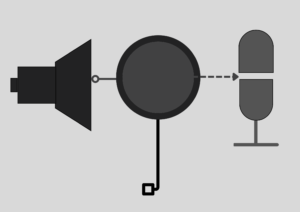Sound is an integral component in filmmaking. Sound recording is a major responsibility for a filmmaker. If the sound use in the movie is not as per the story and situations then no matter how good your movie is, it’s going to disengage the audience and thereby affects the box office performance of the film.
Capturing the sound is important activity. Technically there are four significant components in sound recording:
Sound Source
From the sound source, by way of the air, sound waves travel
Microphone
Microphone makes the sound louder and converts the sound waves into an electrical signal.
Third the small electrical signal is built up by a preamplifier. Preamplifier is an electronic gadget that intensify the weak signals and transfer it to a main amplifier.
Recording Gadget
The fourth significant component in sound recording is a recording device from which the signal is digitalized. The important point here is your recording device defines the quality of the output.
Tips to improve the sound recording:
Stand Very Close to Your Mic
Any diaphragm microphone is good for recording sound and it always viable to stand very very close to the mic. It will not only give you crisp results but increase the bass with a prominent boost. But the big problem is the pulmonic consonant (plosive) that can occur with certain words of the speech or song which can disturb the intimacy. Placing the pop filter in between the mic and the performer can get rid of the plosive problem.
Use a decent preamplifier.
To get a good signal to noise ratio proportion you need a good quality preamplifier. A Preamp is a necessity to avoid the feeble sound in the recording. Many technicians do not use preamp, but to avoid later difficulties it is worth to buy an external mic preamp and the easiest way to repair the lower signal levels is to get one of those inline booster preamps that combines together the microphone and your existing preamp in the audio interface. This will ultimately produce a healthy output of 25 to 30db.
Mind your surroundings
Always pay attention pay attention to the sound of the room. Natural voice like of birds humming and likewise, smaller sound such as those of a fan, Air conditioner or even the fridge can be disturbing. Such silly noise pollution could impact your recordings. If your studio set up is at home then you may install sound proof glasses to your windows.
Record “Room tone”.
Every room has a certain sound. Room tone is basically the sound of a room which is used by the sound recorder between the scenes. For example, in a scene, two people are sitting in a living room and involved in a casual chat. When the scene is completed the sound engineer will record the sound of the room to place in between the scene. When inserting room tone into any scene, one must consider the sound elements coming from fan, air conditioner etc. The scene will look strange and it will look good if it has at least 60 seconds recorded room tone to fill the void.
Use a compressor
The use of compressor in the post-production greatly helps the quality and understandability of the track. Compression can easily make low volume to little louder. This is because of the wide amplitude range of the human voice which can surprisingly change peach.
To achieve the video editing in any order and with great flexibility, the Non-linear video editing software (NLE) comes with a compressor plugin, and if not, it is also available free on the internet.
compressor plugin gives you RTA i.e., Ratio, threshold and auto gain.
The Ratio is amount of compression that will take place
For instance: A ration of 3:1 denotes that for every three dB above the threshold, one dB will be a turnout.
The Threshold denotes the point from which a compressor starts functioning. It is the first setting on a compressor, when set, the compressor starts working on the signal. So, in order to start all the way from the top, you have to lower the threshold for putting your compressor on work.
The Auto gain on a compressor is indemnifying gain for compression that crop up.
Sound recording is an art which involves the science of filling appropriate sound in the vacuums and hollow of filmmaking process. This aspect cannot be ignored, if you want a quality output.




Gospel Songs 2019/2020 On this Website, Download Your Favourite Praise And Worship GGospel Songs Mp3, Videos With Lyrics, And Lyric Video From Nigerian Artists, Ghanaian.